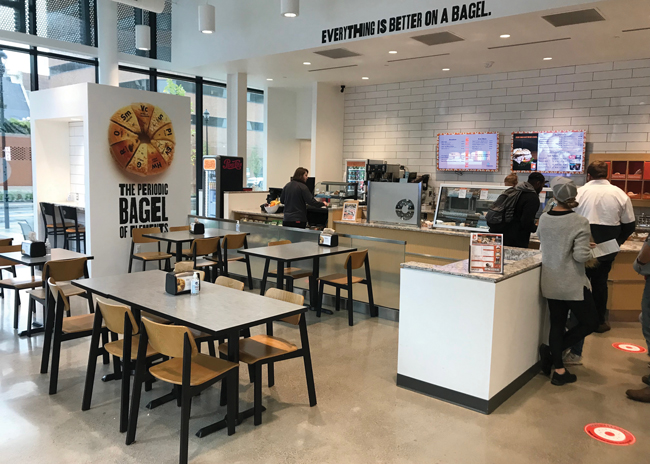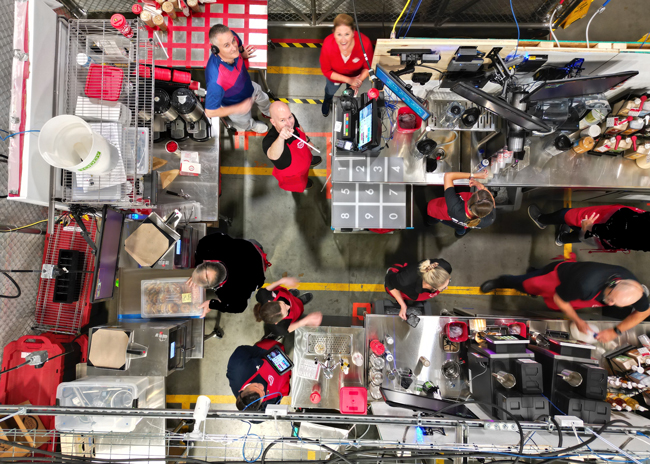 Jim Nussbaum and Mark Greenblatt, CEO and President of Barry Bagels Franchise HoldingsToledo, Ohio-based Barry Bagels has been around for more than 50 years and currently has 20 units open around the Midwest. That’s about to change, though. The company is pursuing an aggressive expansion strategy with more than 60 locations in development, including a 30-store deal in Texas.
Jim Nussbaum and Mark Greenblatt, CEO and President of Barry Bagels Franchise HoldingsToledo, Ohio-based Barry Bagels has been around for more than 50 years and currently has 20 units open around the Midwest. That’s about to change, though. The company is pursuing an aggressive expansion strategy with more than 60 locations in development, including a 30-store deal in Texas.
The heart of the chain’s expansion plan is the hub-and-spoke model. This approach utilizes one hub location that bakes bagels for its own customers but also bakes for two or three nearby stores. This approach gives franchisees the ability to quickly add stores with small footprints in prime locations.
Barry Bagels CEO Jim Nussbaum and President Mark Greenblatt discuss this approach and how the company aligns its interests with those of its franchisees.
How did you develop the hub-and-spoke model for Barry Bagels?
Mark Greenblatt: We sort of stumbled upon it by accident. We had a corporate store that was 7,500 square feet. A Costco came in with a developer and wanted to redevelop the whole area and we were told we could stay, which was very nice of them, but we had to shrink down to 3,000 square feet because they tripled our rent. So, we scrambled and designed a store for that footprint. At the 11th hour, the engineers realized that we had no oven in the store. It was very late in the game, and we didn’t want to go back to the drawing board. We had to proceed with construction, so my dad [concept founder Barry Greenblatt] and I came up with the idea. Our original corporate store, which we still operate, is pushing 7,000 square feet, so we had room for a second oven. The store that we were developing was about 5 miles away. We thought, how about we just fire up two ovens, and we bake bagels all day long and just truck them back and forth to this store. It’s worked out pretty well. We’ve actually transitioned two corporate stores that are in close proximity to operate that way.
What’s the real estate strategy for these different types of locations?
MG: Our hubs range somewhere from 2,800 to 3,500 square feet. That bigger location may not necessarily be in an A+ spot. It can be a B location, where we can go a little bigger and the rent’s a little more affordable. We put a commissary-like kitchen into those spaces. We then go out and find an A+ smaller location, a 1,500 square foot and below storefront, and truck the bagels to it.
 Barry Bagels has found success using a hub-and-spoke model where the hub bakes fresh daily and product is moved to the smaller spoke stores. Image courtesy of Barry Bagels
Barry Bagels has found success using a hub-and-spoke model where the hub bakes fresh daily and product is moved to the smaller spoke stores. Image courtesy of Barry Bagels
How do you create a cohesive customer experience across these different types of locations?
Jim Nussbaum: We run our lines the same way at hubs and spokes, meaning we take your order at the beginning, move you down the line and ring you out at the end. You generally move facing team members and vice versa. So, they’re interacting while the order is being prepared. That’s very consistent throughout our stores.
MG: Obviously the bigger locations are geared a little bit toward a little more dining. We like to give you that personal experience, especially at the hub stores. We also like you to see how everything is made. It’s a little bit like a donut shop, where there’s a window, and you can watch us put the bagels on the pans and stuff like that, so [customers] know what’s going on.
What qualifies as a good spoke location for Barry Bagels?
MG: We’ve got a little bit of everything, from inline to as small as a kiosk — it might be just 400 square feet.
JN: The utilization of the spoke model does allow extreme flexibility. For example, we have a spoke inside Toledo Hospital, in Ohio. We have a spoke inside of the museum of science and industry in Toledo. When you don’t have kitchen manufacturing equipment, you can put things in smaller places and be more flexible. So, our list of potential locations now could be food courts, airports — any place that can be served by that centralized hub location. It allows us tremendous flexibility in determining where we want to be.
Besides rent, what are the benefits of the hub-and-spoke model?
JN: There’s a significant labor benefit at the spoke store. At the hub, somebody’s already there baking, so it’s not an additional FTE for someone to go in there and bake for additional stores. You are saving labor in the spoke store because you do not need that on-site baker. You also do not need the CapEx for an oven, a kettle, a hood, the HVAC or the walk-in cooler. That decreases the cost to build a store. And if you have multiple stores, you can then spread out your marketing budget and administrative costs.
What are the challenges to this approach?
JN: A hub can support itself and probably two to three more stores. If you have a store with only one oven that’s supporting three or four stores and that oven stops, then you have a cessation of activity across all those stores. Being cognizant of that means you might want a backup oven, so your entire market doesn’t shut down if a repair needs to be made.
Another challenge is communication. If there’s sort of a “run on the bank” at a spoke, they need to communicate back to the hub that they need more bagels and what kind. That’s easy when you’re within the hub and the oven is 3 feet away. But with this approach there’s a higher level of communication required.
What areas are you targeting for growth? What type of markets are you targeting?
JN: Our plan is 80% strategic, 20% opportunistic. The strategic plan is to grow outward in sort of circles from where we are. Now have stores in Dayton [Ohio], Indianapolis, Louisville [Kentucky], Columbus [Ohio] and Cleveland. The next ring of that would be places like Pittsburgh, Lexington [Kentucky], maybe up through Illinois, then Nashville [Tennessee], and maybe Milwaukee. This allows us to be thoughtful relative to factors like marketing and supply chain management. The 20% opportunistic part involves a combination of factors. There could be a very appealing market combined with — and this is more important — a unique opportunity relative to an operating partner. That can be because of their sophistication or food service experience or familiarity with Barry Bagels. That’s when we consider going outside of that geographic area that I described. That’s really what happened with our Dallas deal. We have somebody who we know, who used to work at Barry, who has experience, not only with food service but with us in particular and who also has management experience.
In terms of city, suburb or college town, we think, in a humble way, we fit with all those. There just needs to be a critical mass relative to population. Whether that population is made up of college kids or working adults is less important than just being in moderately densely populated areas.



